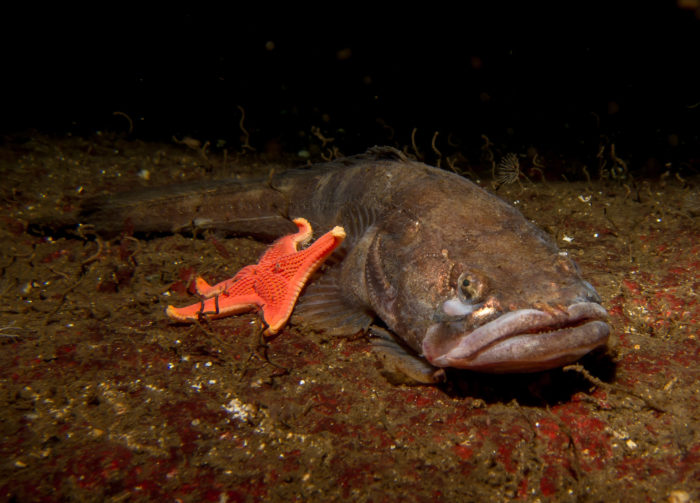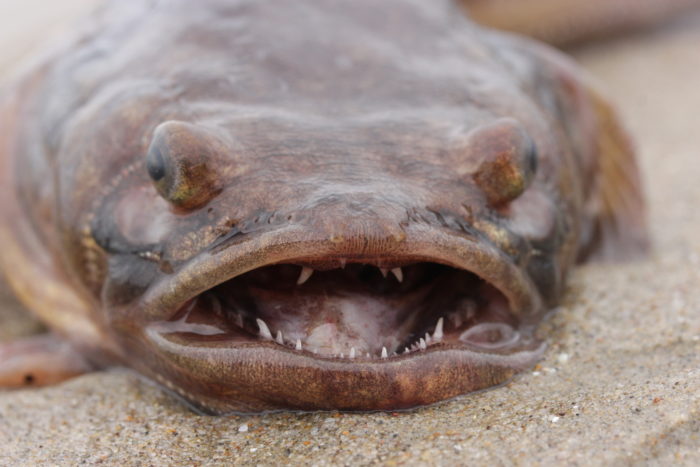
Sea Wonder: Plainfin Midshipman

Photo credit: Ron Caswell
The plainfin midshipman is anything but ordinary!
Description
Plainfin midshipmen belong to the same ecological family as toadfishes, which, you guessed it, are named for their toad-like appearance! Midshipmen have photophores on their heads, flanks, and bellies, and these organs emit light to attract prey when foraging and mates during courtship season. Because their photophores resemble the buttons on a naval officer’s uniform, they earned the name “midshipman”. They can grow up to 15 inches long and have two spines on its dorsal side and between 33 and 37 soft rays (fringe-like structures) along their backs.
Plainfin midshipmen have a long, flatter body with wide pectoral fins on their side and a rounded tail fin at the end of their bodies. Their coloration is often mottled patterns of brownish to olive, with iridescent purple on their backs, and yellow hues on their bellies. Under each eye, they have a black crescent and a whitish patch. Juveniles often have a darker saddle patch on their dorsal side, which changes color as they reach adulthood. With their gills, plainfin midshipmen can breathe in and out of the water.
Diet & Habitat
The plainfin midshipman diet feeds on crustaceans and smaller fish. They are most often preyed upon by marine mammals and marine birds. The fish’s color helps it blend into the muddier sediments along which it lives, and its photophores help it attract prey while the midshipman stays almost completely still. When a morsel gets close enough, the plainfin midshipman ambushes its target and engulfs it in the fish’s large mouth.
Midshipmen have evolved to survive in the stressful extreme conditions of the intertidal zone for up to eight hours. In response to low dissolved oxygen levels in the water (i.e. aquatic hypoxia), nesting males can drop their metabolic rate and increase lactate in their heart and glucose in their liver to overcome physiological stress of hypoxia. They can live in deeper to more coastal waters, reaching depths of more than 300 meters; they generally move to the shallower intertidal zones during the summer breeding season. This species is only found in the Eastern Pacific region of the ocean, spanning from waters near British Columbia, Canada down to Baja California Sur, Mexico. In the National Marine Sanctuary System, we see them in or near Olympic Coast, Greater Farallones, Cordell Bank, Monterey Bay, Channel Islands, and the proposed Chumash Heritage National Marine Sanctuaries.
Life History
The plainfin midshipman is oviparous, which means females lay eggs outside of their bodies. Courtship occurs in the summer months when waters are warmer and food is plentiful, and involves males excavating nests in the sediment for potential females to lay and guard their eggs. Males vie for female attention through courtship behavior that relies on acoustic communication, though not all males have this skills. Some plainfin midshipmen “sing” to their potential mates by producing a loud, droning hum during mating season to impress females, humming that can be heard by humans in quieter areas of the intertidal zone if they listen closely.
Only some male midshipmen can hum; these are called Type I, or parental, males. The hum they produce is a low-pitched sound generated by the rapid contraction of the drumming muscles on the male’s swim bladder. All of the humming males together sound like a huge hive of bees or a group of motorboats, a sound loud enough to be heard by people on nearby land. In addition to hums, Type I male plainfin midshipmen can two other types of vocalizations. Plainfin midshipmen can regulate their hearing so that they are not deafened by their own humming and can hear other animals while vocalizing.
Type II or “sneaker” males are smaller than Type I males, do not build nests, and cannot sing. Unable to attract females, sneaker males hang around the nests of humming Type I males and quickly dart into this other male’s nest when a female enters, and fertilize her eggs.
After successfully attracting a female, she will lay her eggs and leave the nest. The male will fertilize the eggs and stay to guard his nest until the offspring hatch and mature. A single male may fertilize and guard as many as 1,300 eggs, which hatch a few days to weeks after fertilization.
Threats & Conservation
The plainfin midshipman is listed as a species of Least Concern on the IUCN Red List, which means populations are likely healthy and stable. They are caught by recreational harvesters within Puget Sound and along the outer coast, though it’s unlikely they are currently overexploited or at risk of overexploitation.
During low tide, these fish must contend with extreme environmental conditions and predators unique to the intertidal habitat, like the great blue heron. They’re well-suited for their habitats, but future changes to the ocean – like warming, ocean acidification, and pollution – may cause harm to individuals, groups, and the species.

Photo credit: Björn S.
